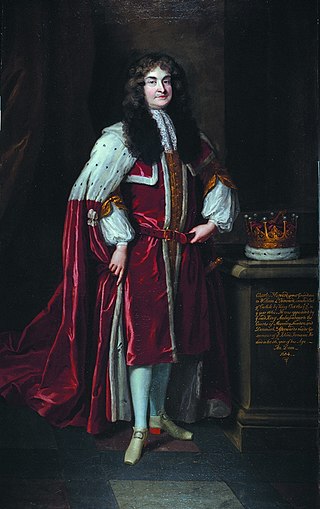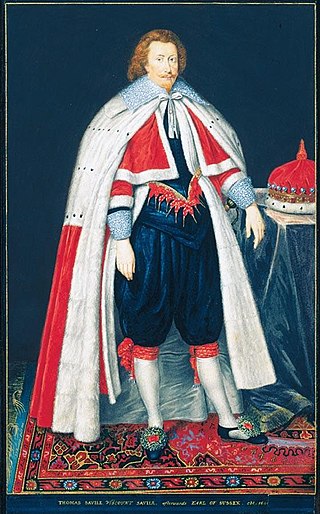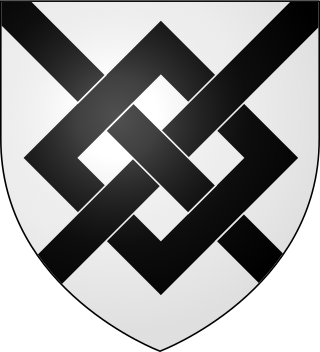Related Research Articles

Earl of Derby is a title in the Peerage of England. The title was first adopted by Robert de Ferrers, 1st Earl of Derby, under a creation of 1139. It continued with the Ferrers family until the 6th Earl forfeited his property toward the end of the reign of Henry III and died in 1279. Most of the Ferrers property and the Derby title were then held by the family of Henry III. The title merged in the Crown upon Henry IV's accession to the throne in 1399.

Edward Villiers, 1st Earl of Jersey was an English peer, courtier, and statesman of the Villiers family. He was created Baron Villiers and Viscount Villiers in 1691 and Earl of Jersey in 1697. A leading Tory politician opposed to the Whig Junto, he was made Southern Secretary in 1699.

Earl of Suffolk is a title which has been created four times in the Peerage of England. The first creation, in tandem with the creation of the title of Earl of Norfolk, came before 1069 in favour of Ralph the Staller; but the title was forfeited by his heir, Ralph de Guader, in 1074. The second creation came in 1337 in favour of Robert de Ufford; the title became extinct on the death of his son, the second Earl, in 1382. The third creation came in 1385 in favour of Michael de la Pole. The fourth creation was in 1603 for Lord Thomas Howard, the second son of Thomas Howard, 4th Duke of Norfolk, by his second wife Margaret Audley, the daughter and eventual sole heiress of Thomas Audley, 1st Baron Audley of Walden, of Audley End in the parish of Saffron Walden in Essex. Howard was a prominent naval commander and politician and served as Earl Marshal, as Lord Chamberlain of the Household and as Lord High Treasurer. In 1597 he was summoned to Parliament as Baron Howard de Walden, and in 1603 he was further honoured, at the start of the reign of King James I, when he was created Earl of Suffolk. His second son the Hon. Thomas Howard was created Earl of Berkshire in 1626.

Earl of Effingham, in the County of Surrey, is a title in the Peerage of the United Kingdom, created in 1837 for Kenneth Howard, 11th Baron Howard of Effingham, named after the village of Effingham, Surrey, where heads of the family owned the manor.

Charles Howard, 1st Earl of Carlisle was an English military leader and politician who sat in the House of Commons at various times between 1653 and 1660 and was created Earl of Carlisle in 1661.

Thomas Howard, 1st Earl of Suffolk, of Audley End House in the parish of Saffron Walden in Essex, and of Suffolk House near Westminster, a member of the House of Howard, was the second son of Thomas Howard, 4th Duke of Norfolk by his second wife Margaret Audley, the daughter and eventual sole heiress of Thomas Audley, 1st Baron Audley of Walden, of Audley End.

Henry Howard, 6th Duke of Norfolk was an English nobleman and politician. He was the second son of Henry Howard, 22nd Earl of Arundel, and Lady Elizabeth Stuart. He succeeded his brother Thomas Howard, 5th Duke of Norfolk after Thomas's death in 1677.
Edward Howard or Ed Howard may refer to:

Thomas Howard, 1st Earl of Berkshire was an English politician who sat in the House of Commons between 1605 and 1622. He was created Earl of Berkshire in 1626.

Thomas Knyvet, 1st Baron Knyvet was an English courtier and Member of Parliament who played a part in foiling the Gunpowder Plot.

Baron Howard of Escrick was a title in the Peerage of England. It was created on 12 April 1628 for Edward Howard. A member of the influential Howard family, he was the youngest son of Thomas Howard, 1st Earl of Suffolk, the son of Thomas Howard, 4th Duke of Norfolk by his second wife Margaret Audley. The third Baron represented Winchelsea in the House of Commons and was also accused of being involved in the Rye House Plot; later he became a notorious informer in State trials, earning much hatred and contempt as a result. The title became extinct on the death of his son, the fourth Baron, in 1715.
Henry Nevill, de facto 9th Baron Bergavenny was an English iron founder, soldier and politician who sat in the House of Commons at various times between 1601 and 1622 when he inherited the Baron Bergavenny peerage.
William Howard, 3rd Baron Howard of Escrick was an English Parliamentarian soldier, nobleman, and plotter.

Thomas Savile, 1st Earl of Sussex was an English politician.

John Mordaunt, 1st Earl of Peterborough was an English peer.
Sir Robert Howard KB was an English landowner, member of parliament, and Royalist soldier. He was involved in a scandal when his mistress Frances Coke, Viscountess Purbeck, was found guilty of adultery and was twice summoned to explain her pregnancy with his son to the Court of High Commission. During the English Civil War, Howard was in command of the defence of Bridgnorth Castle when it surrendered to the Parliamentarians in 1646.

Sir Lionel Tollemache, 2nd Baronet PC, of Helmingham Hall in Suffolk, was twice elected as a Member of Parliament for Orford in Suffolk, in 1621 and 1628. He had a considerable reputation as a surgeon, but is said to have made many enemies due to his "immoderate temper".
Sir William Howard of Tollesbury Hall, Essex was an English courtier and a member of Parliament between 1624 and 1640.

The title Baron Cobham has been created numerous times in the Peerage of England; often multiple creations have been extant simultaneously, especially in the fourteenth century.
References
- 1 2 3 "HOWARD, Sir Edward II (?1602-1675), of Escrick, Yorks. and Tollesbury Hall, Essex". History of Parliament Online. Retrieved 24 June 2013.
- ↑ Ruigh, R.E. (1971). The Parliament of 1624: Politics and Foreign Policy. Harvard historical studies. Harvard University Press. p. 87. ISBN 978-0-674-65225-5.
- ↑ Morant, Philip (1768). The history and antiquities of the county of Essex. Vol. 1. p. 402.
- 1 2 One or more of the preceding sentences incorporates text from a publication now in the public domain : Chisholm, Hugh, ed. (1911). "Suffolk, Thomas Howard, 1st Earl of". Encyclopædia Britannica . Vol. 26 (11th ed.). Cambridge University Press. p. 26.
- ↑ Christianson, Paul (1977). "The Peers, the People, and Parliamentary Management in the First Six Months of the Long Parliament". The Journal of Modern History. 49: 598.
- ↑ "A History of the County of York East Riding: Vol. 3: Escrick". British History Online. Retrieved 30 November 2023.
- ↑ John Nichols, Progresses of James the First, vol. 4 (London, 1828), p. 927.
- Lee, Sidney, ed. (1891). . Dictionary of National Biography . Vol. 28. London: Smith, Elder & Co.